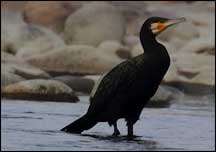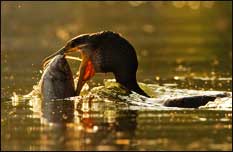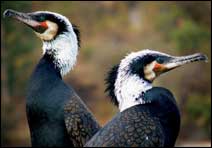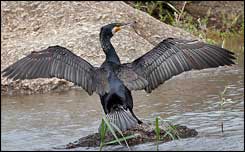Great Cormorant
Introduction
Page 1 of 4
The Great Cormorant with the scientific name
of Phalacrocorax fuscicollis is one of the members of the cormorant family. The name cormorant is derived from the Latin word corvus marinus, which means 'sea crow'.
It is commonly seen along the inlands of the Indian Subcontinent. It is one of the gregarious species found in India. So, it can be easily distinguished from the other cormorants. The quick classification of the Great cormorant is given below,
| Kingdom |
Animalia |
| Phylum |
Chordata |
| Class |
Aves |
| Order |
Pelecaniformes |
| Family |
Phalacrocoracidae |
| Genus |
Phalacrocorax |
| Species |
Phalacrocorax fuscicollio |
Physical Characteristics:
Great Cormorant is one of the beautiful birds, which is is widely spread around the world. It has a good fishing ability. The length of this great cormorant is in the range of 80 to 100 cm. The wingspan of this bird is in the range of 130 to 160 cm. The weight of this great cormorant is 1800 to 2800 g. The life span is up to 23 years. The chin of this cormorant is black in colour and its cheeks and throat is in bare white colour.
The head is black in colour. This great cormorant has white short feathers extending broadly on the rear neck and ending on the fore neck. It has short legs which are in black colour and also have emerald eyes. It has a thin and straight bill. Both male and female great cormorant look similar. But the male cormorant is slightly larger when compared to the female cormorant. The male cormorant has a larger bill than the female. The young cormorant reaches its sexual maturity at 3 to 5 years.
Behaviour
Page 2 of 4
The Great Cormorant is very silent in nature when they are away from their colony.
It feeds in the shallow water. It uses its bill to catch the prey. It has the ability to swim under water. Apart from the breeding season, this great cormorant is usually seen alone. But, in the breeding season, they are grouped together in a single colony. It used to regurgitate after feeding. It takes 400 to 700 grams of fish per day as its food. The great cormorant forms the V shape while taking flight.
The Great Cormorants are considered as a competitor by fishermen. The Great cormorant has been persecuted by them. It has good fishing ability. It sometimes helps humans to catch the fish without swallowing. Great Cormorants' feathers allow air to escape and water to penetrate the plumage.
Habitat:
The great cormorants are commonly seen in the estuaries, sandy sheltered and rocky coastal areas. They build their nest close to reservoirs, freshwater lakes and gravel pits. They are frequently found in the marine and inland waters. The great cormorants spend their time by sitting on the trees or manmade structures.
Migration:
These greater cormorant birds will take some seasonable movements in the winter season toward where there is an adequate supply of fish. The birds which are living in the north side will migrate towards the south side and vice versa.
Food Habits:
The great cormorant mainly prefers fish as their food. Sometimes, they also eat crustaceans and amphibians. They take the food found in the seas, rivers and freshwater lakes. It dives into the water to find its prey.
Mating and Nesting
Page 3 of 4
The Great Cormorant breeds at any time,
depending on the food resources available in their breeding areas. But, they breed only one time per year. They breed in colonies. Up to 2000 pairs may gather in a single colony. They choose the colonies closed to other species like darters, spoon bills and herons. They use the sticks, seaweeds and reeds to build the nests. The interior portion of the nest is built with soft materials. They build the nests in the cliffs, bushes or trees.
The female lays 2 to 6 eggs at a time. Both male and female great cormorant are involved in the incubation. The incubation period of this great cormorant is 27 to 31 days. They use their large webbed feet to incubation. They place the eggs above the feet and incubate it.
Chicks hatch at intervals. The young one is blind and naked at the time of hatching. Both male and female cormorant feed the young ones with the regurgitated liquid in the first few days. After that, they give solid food for their chicks.
The chicks will take that solid food directly into their throats. The young ones will stay with their parents up to 50 days.
Places Found
Great Cormorant is one of the widespread species in the world which is commonly seen in the temperate areas of the Old World. Great Cormorant is commonly found in the countries like northern Atlantic, Britain, Africa, North east Scotland, Eurasia and Australasia.
Threats and conservation
The Great cormorants are threatened by the habitat destruction which reduces the suitable nest sites. The other main reason for the threats are climate changes, disease, predators, reduction of food species in their living places. Nowadays, variety of conservation efforts have been taken to protect the breeding sites of the Great cormorant. The great cormorant is protected under the Wildlife and Countryside Act of 1981.
Subspecies of Great Cormorant in India
Page 4 of 4
There are several sub-species of Greater Cormorant found in the world. They are,
1. Phalacrocorax carbo sinensis
2. Phalacrocorax carbo carbo
3. Phalacrocorax carbo maroccanus.
4. Phalacrocorax carbo hanedae
5. Phalacrocorax carbo novaehollandiae
6. Phalacrocorax carbo lucidus
Interesting facts about Great Cormorant
1. There are totally 38 species of the cormorants recognized in the world. Among that 3 species of cormorants are found in India.
2. The cormorants commonly seen in India are, Indian Cormorant with the scientific name of Phalacrocorax fuscicollis, Great Cormorant with the scientific name of Phalacrocorax carbo and Little Cormorant with the scientific name of Phalacrocorax niger .






